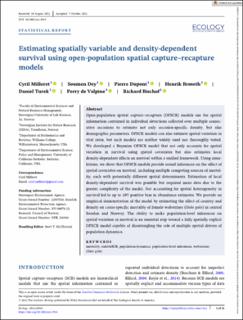| dc.contributor.author | Milleret, Cyril Pierre | |
| dc.contributor.author | Dey, Soumen | |
| dc.contributor.author | Dupont, Pierre | |
| dc.contributor.author | Brøseth, Henrik | |
| dc.contributor.author | Turek, Daniel | |
| dc.contributor.author | Bischof, Richard | |
| dc.date.accessioned | 2023-01-25T09:35:31Z | |
| dc.date.available | 2023-01-25T09:35:31Z | |
| dc.date.created | 2023-01-24T09:47:31Z | |
| dc.date.issued | 2022 | |
| dc.identifier.issn | 0012-9658 | |
| dc.identifier.uri | https://hdl.handle.net/11250/3046133 | |
| dc.description.abstract | Open-population spatial capture–recapture (OPSCR) models use the spatialinformation contained in individual detections collected over multiple consec-utive occasions to estimate not only occasion-specific density, but alsodemographic parameters. OPSCR models can also estimate spatial variation invital rates, but such models are neither widely used nor thoroughly tested. We developed a Bayesian OPSCR model that not only accounts for spatialvariation in survival using spatial covariates but also estimates localdensity-dependent effects on survival within a unified framework. Using simu-lations, we show that OPSCR models provide sound inferences on the effect ofspatial covariates on survival, including multiple competing sources of mortal-ity, each with potentially different spatial determinants. Estimation of localdensity-dependent survival was possible but required more data due to thegreater complexity of the model. Not accounting for spatial heterogeneity insurvival led to up to 10% positive bias in abundance estimates. We provide anempirical demonstration of the model by estimating the effect of country anddensity on cause-specific mortality of female wolverines (Gulo gulo) in centralSweden and Norway. The ability to make population-level inferences onspatial variation in survival is an essential step toward a fully spatially explicitOPSCR model capable of disentangling the role of multiple spatial drivers ofpopulation dynamics. Smortality, nimbleSCR, population dynamics, population-level inferences, wolverines(Gulo gulo) | en_US |
| dc.description.abstract | Estimating spatially variable and density-dependent survival using open-population spatial capture–recapturemodels | en_US |
| dc.language.iso | eng | en_US |
| dc.rights | Navngivelse 4.0 Internasjonal | * |
| dc.rights.uri | http://creativecommons.org/licenses/by/4.0/deed.no | * |
| dc.subject | mortality | en_US |
| dc.subject | nimbleSCR | en_US |
| dc.subject | population dynamics | en_US |
| dc.subject | population-level inferences | en_US |
| dc.subject | wolverines (Gulo gulo) | en_US |
| dc.title | Estimating spatially variable and density-dependent survival using open-population spatial capture–recapturemodels | en_US |
| dc.title.alternative | Estimating spatially variable and density-dependent survival using open-population spatial capture–recapturemodels | en_US |
| dc.type | Peer reviewed | en_US |
| dc.type | Journal article | en_US |
| dc.description.version | publishedVersion | en_US |
| dc.rights.holder | © 2022 The Authors | en_US |
| dc.subject.nsi | VDP::Zoologiske og botaniske fag: 480 | en_US |
| dc.subject.nsi | VDP::Zoology and botany: 480 | en_US |
| dc.source.journal | Ecology | en_US |
| dc.identifier.doi | 10.1002/ecy.3934 | |
| dc.identifier.cristin | 2113763 | |
| dc.relation.project | Norges forskningsråd: 286886 | en_US |
| dc.relation.project | Miljødirektoratet: 22047026 | en_US |
| dc.relation.project | Andre: Swedish Environmental Protection Agency NV-04078-22 | en_US |
| dc.source.articlenumber | e3934 | en_US |
| cristin.ispublished | true | |
| cristin.fulltext | original | |
| cristin.qualitycode | 2 | |

